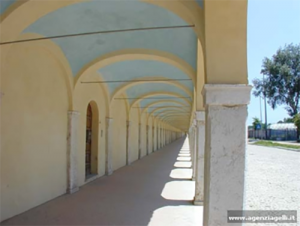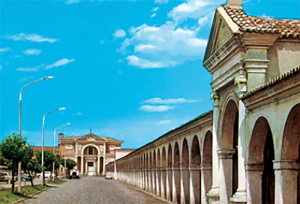 Percorrendo via Mazzini troviamo il loggiato dei Cappuccini, che ha 142 archi supportati da alcune colonne di marmo. Il loggiato raggiunge il santuario che è dedicato alla veneratissima immagine della Madonna.
Percorrendo via Mazzini troviamo il loggiato dei Cappuccini, che ha 142 archi supportati da alcune colonne di marmo. Il loggiato raggiunge il santuario che è dedicato alla veneratissima immagine della Madonna.
La storia del Santuario si è persa nel tempo, (il primo riferimento ad esso in documenti storici risale al decimo secolo). L’attuale edificio risale alla seconda metà del diciassettesimo secolo.
All’ interno la navata è coperta con volte a crociera su strisce a lesene. Sul lato destro si trovano le cappelle intercomunicanti.
Oltre alle richieste di devozione per salvare Comacchio dalle acque del Po nel 1645, fu intenzione del Cardinale Stefano Donghi connettere il loggiato alla chiesa e alla città in modo da offrire ai visitatori una prospettiva migliore della città dalla terra ferma.
Nel Santuario a singola navata, un altare ligneo espone una bellissima terracotta della Vergine e del Bambino del quindicesimo secolo, venerata come santa patrona della città.
Vicino al Santuario vi è il Museo Mariano di arte sacra moderna che raccoglie preziose opere prodotte da grandi artisti da Sepo a Remo Brindisi.
Capuchin Arcade
 Going along Via Mazzini one arrives at the Capuchin Arcade, which has 142 arches supported by as many marble columns. The Arcade reaches as far as the Sanctuary of the Royal Court, which is dedicated to a highly venerated image of the Madonna.
Going along Via Mazzini one arrives at the Capuchin Arcade, which has 142 arches supported by as many marble columns. The Arcade reaches as far as the Sanctuary of the Royal Court, which is dedicated to a highly venerated image of the Madonna.
The history of the Sanctuary is lost in the mists of time, (the earliest mention of it in historical documents goes back to the tenth century). The present building is from the second half of the seventeenth century. Inside, the nave is roofed with cross vaults set on pilaster stripes, whilst on the right-hand side can be found the intercommunicating chapels.
Besides devotional requests to rescue Comacchio from the waters of the Po in 1645, it was the intention of the cardinal legate Stefano Donghi that the arcade, connecting the church to the city, would offer visitors from the mainland, a doubly greater prospect of the city.
In the single-aisle sanctuary, the wooden altarpiece displays a beautiful 15th – century terracotta of the Virgin and Child, venerated as the city’s patron saint.
Adjoining the Sanctuary is the Marian Museum of modern sacred art that gathers precious works produced by many great artists ranging from Sepo to Remo Brindisi.
